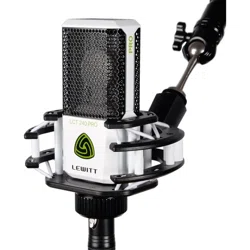Loading ...
Loading ...
Loading ...

6
// The LEWITT logo indicates the front of the microphone. The front should always
face the sound source you are planning to record.
// Connect the LCT 240 PRO via standard 3-pin XLR cable to your recording
device or preamp. Make sure it is capable of providing 48V phantom power (P48).
// Mute your microphone channel before you turn the phantom power on - it
produces a switch-on sound.
// Finding the right gain setting - Set the input gain on your recording interface
according to the sound source you want to record. Just play or sing the loudest
part of the track you are about to record and nd the right gain setting. With having
your peaks around -12 dBFS you will be save in most cases, and do not need to
worry about ugly distortions but still have a good signal-to-noise ratio.
5. Before you start
Before you can start recording, you should check if you have all the necessary
equipment. A microphone alone is not able to complete this task - not even ours.
// Nowadays the easiest and most uncomplicated way is to buy a microphone and
an audio interface that you can connect to your computer. This setup is the most
cost-efcient recording solution.
// Make sure that your audio interface has an XLR-input channel that can supply
48V phantom power.
// You also need a 3-pin XLR cable and a sturdy microphone stand.
// There are several software solutions (DAW = Digital Audio Workstation) available
that serve as your digital studio. Their functionality ranges from basic recording
functions to studio professionality.
6. Setting up your LCT 240 PRO
// The LCT 240 PRO comes with a mic mount. Attach the mount to a stable and
sturdy microphone stand. Put the LCT 240 PRO into the mount and secure it by
fastening the screw by turning it clockwise. Make sure the LEWITT logo faces
your sound source.
// If you are planning to record vocals or spoken word, make sure to use a pop
lter. A pop lter prevents plosive sounds that are overloading the signal. Plosive
sounds are occurring when pronouncing aspirated plosives, which are sounds that
are accompanied by a strong burst of breath, e.g. P(opping) in spoken language.
Loading ...
Loading ...
Loading ...
